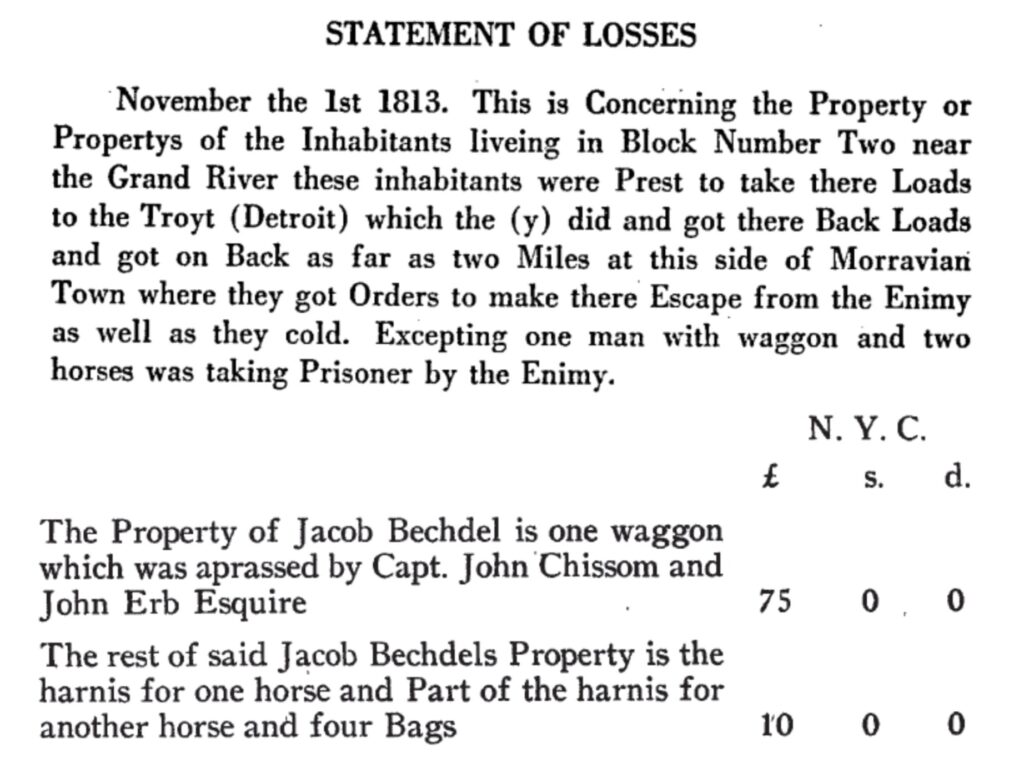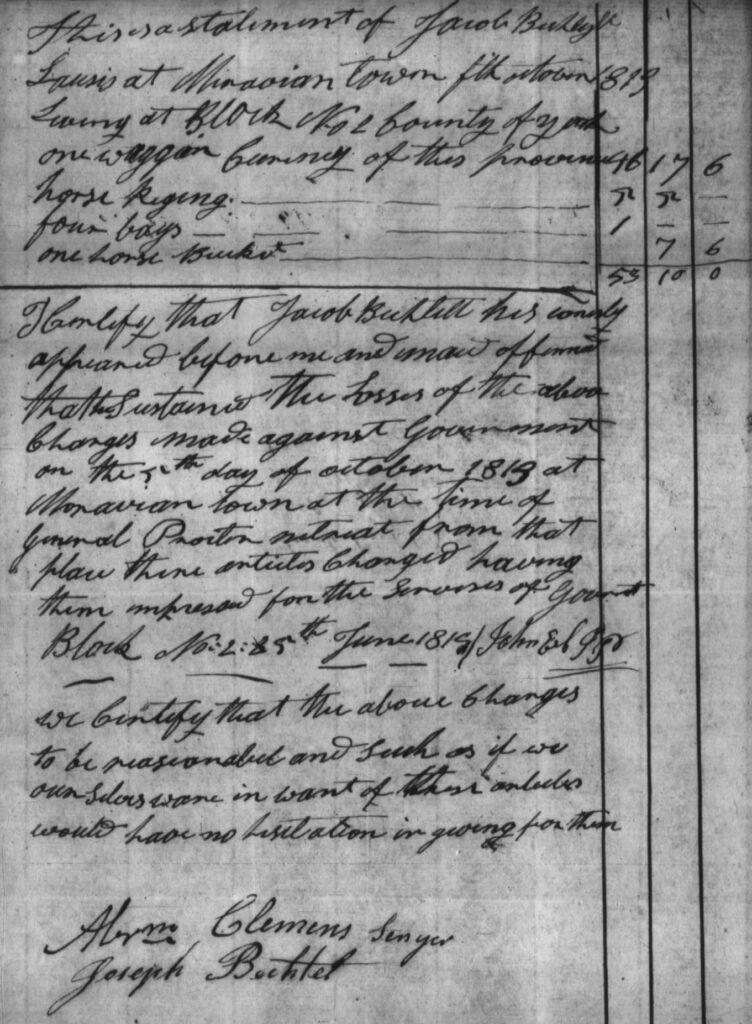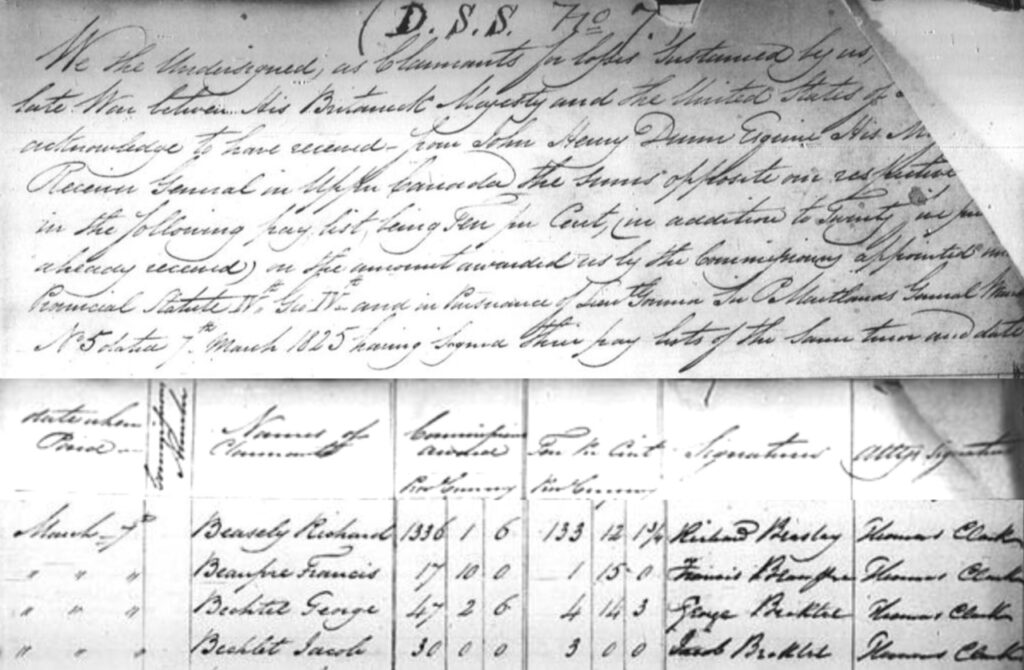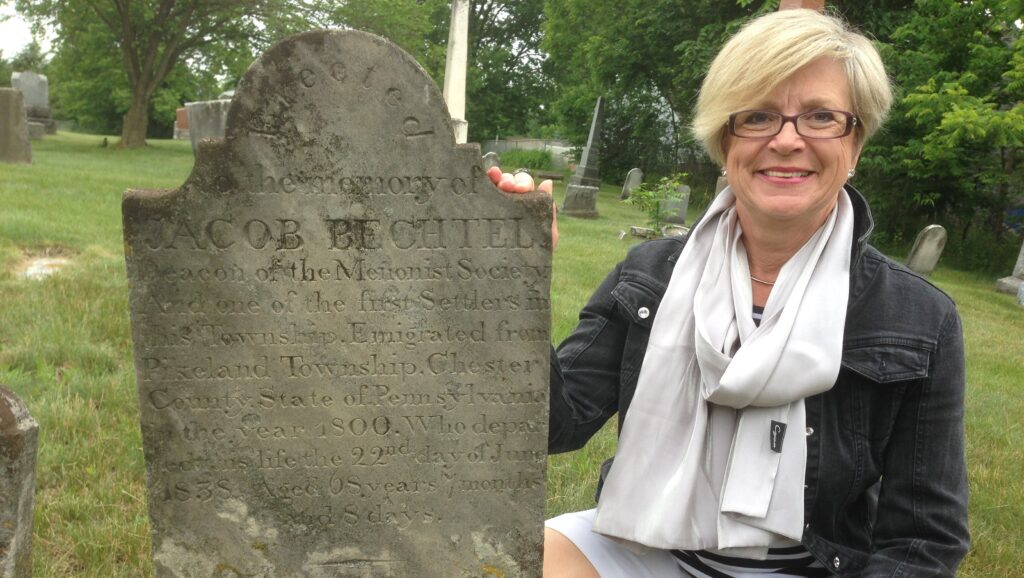This article tells the story of my wife Diane’s four times great grandfather Jacob Bechtel and his role as a teamster during the War of 1812. He lost his heavy wagon and other gear during the Battle of the Thames at Moraviantown in October 1813 and spent years seeking compensation.
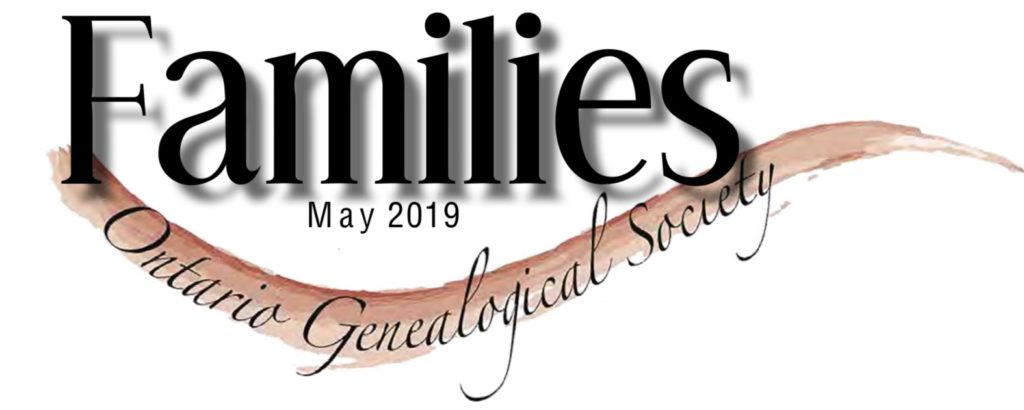
In an accompanying paper I discuss how seeking membership in Genealogical Heritage Societies can help amateur family historians hone their documentation skills. In this article I take a deeper dive into the facts of one of the two case studies described in that paper, a unique application for membership in the OGS War of 1812 Heritage Society. The application was unique in that it is the first time an application has been made based upon participation in that war of a conscientious objector, non-combatant, teamster – involuntarily pressed into service. In this article I will outline the chronology and provide images or transcriptions of various 200 year old documents which have been accessed to recreate the circumstances of this participation.
Deacon Jacob Bechtel (1759-1838) was a leader of the Mennonite community living on the west side of the Grand River near current day Blair, Ontario 1. He had been pressed into service with his horses and wagon as a teamster by the military authorities in the late summer of 1813. Jacob lost his wagon, harness, four bags of feed and a horse bucket at Moraviantown on the Thames River on 5 October 1813 during Major General Proctor’s retreat from the Detroit frontier. Initially in November 1813, and again in 1815, Jacob, along with others who had lost property, submitted claims for their war losses incurred in 1813. I will follow the course of Jacob’s loss through the initial claim documentation to the detailed pay lists which diarize installment receipts over a twenty year period. These documents will illustrate the protracted and somewhat unsatisfactory outcome of that effort to seek compensation from the Upper Canada and British authorities.
Jacob Bechtel Arrives in Upper Canada
In the spring and summer of 1800 Jacob Bechtel emigrated from Pennsylvania to Upper Canada with several other families. He was part of a three generation family unit, including his father Abraham, his uncle George, and his own wife and children 2. There is credible handed down local family tradition which identifies Jacob Bechtel as the first Pennsylvania Mennonite to scout the Waterloo area in the summer of 1799 and the first to meet with Richard Beasley who was selling the land 3. This laid the ground work for the 1800 land purchases along the Grand River and successive waves of Mennonite migration from Pennsylvania.
Abraham Bechtel purchased 200 acres of what was then known as Beasley’s Old Survey Lot 3, Township of Brant, Home District of Upper Canada (also referred to as part of Block Two, Indian Lands, West Riding of York County) on 11 August 1800 4. On 12 September 1800 Jacob Bechtel purchased 100 of those acres from his father 5 and on 23 October 1806 Jacob bought the remaining 100 acres.
Image 1: Lot 3, Beasley Old Survey, Waterloo County Registry Office Records, Abstract Index Book 6
Langdon Hall, near the town of Blair, is located on the western portion of this property 7. Jacob Bechtel’s 1817 farm house, located on the east side of Blair Road on the Grand River, is the oldest known residence in the current City of Cambridge, Ontario and is a designated Heritage Building 8. I will only briefly touch in the end notes on the matter of the controversy over encumbrances on that land as it has been thoroughly discussed by many others 9.
Militia and Billeting Acts
One of the incentives which helped draw the Pennsylvania Mennonites and members of the other “peace churches” to Upper Canada were certain exemptions from bearing arms contained in the Militia Act 1793. The act referred to “scruples of conscience”, which, for the Mennonites, were articulated in the Dordrecht Confession 10. The Militia Act was revised in 1808 to confirm this exemption and again in 1812 to expand it to include young family members of those churches. Provisions of the Militia Act required that to claim exemption residents must pay a “tax” of £5 in war time 11. In 1809 An Act for Quartering and Billeting, on Certain Occasions, his Majesty’s Troops, and the Militia of this Province” allowed the authorities to “impress” boats, wagons, sleighs, and men to drive them, for service to the militia and British forces.
Blockade of Lake Erie
US Navy Master Commandant Oliver H. Perry broke out of Presque Ile Bay (near current day Erie, PA) in the first week of August, 1813 with his fleet of newly built naval vessels 12. Perry then began a blockade of Lake Erie shipping leaving Major General Henry Proctor and his British troops and indigenous allies along the Detroit River with a dwindling stock of food and supplies.
Impressments of Mennonite Settlers with their Horses and Wagons
Military authorities began impressing Mennonite men with their teams of horses and wagons to act as teamsters to transport supplies overland to the forts on the Detroit frontier. At least 20 men, including Jacob Bechtel, were impressed in Block Two, York County along the Grand River, now part of Waterloo Region 13. I’ve not been able to ascertain from the source documents the exact date of the conscriptions but it seems to have been August or September, 1813.
The Battle of Lake Erie
The US Navy won a decisive victory over the Royal Navy in the Battle of Lake Erie off Put-in-Bay on 10 September 1813 14. This victory solidified total control of Lake Erie for the Americans and further highlighted the need for a retreat of the British Army and its indigenous allies from the forts at Detroit and Amherstburg/Malden.
The Retreat from Detroit
On 27 September 1813 Major General Proctor began the retreat of the remnants of the Right Division of the British Army in Upper Canada from Amherstburg up the Thames River supported by the impressed Mennonite teamsters and wagons. He hoped to reach Burlington Heights on Lake Ontario. A large number of indigenous allies under the leadership of Tecumseh had gathered at Amherstburg to seek protection and supplies. They also joined the retreat.
Battle of the Thames
Over 3,500 US troops, mostly state militia and 1,000 of those on horseback, pursued the 1,500 to 1,800 British soldiers and Indian Confederacy forces up the river and overtook them at Moraviantown on 4 October 1813. In another convincing and one sided victory, the Americans routed the British and indigenous forces on 5 October 1813 during what is referred to as the Battle of the Thames or the Battle of Moraviantown 15. Most of the Mennonite wagons and supplies were abandoned at the site of the battle two miles north east of Movaviantown per the claims documents described below. It was at this battle that Tecumseh was killed.
Initial Claim for Compensation
The earliest document I am aware of which references the loss of the Mennonite wagons was a claim for compensation filed by 20 Mennonite teamsters from Block Two on 1 November 1813, produced less than one month after the Battle of the Thames. Below is an extract from the transcription of the document produced by Brigadier General E.A. Cruikshank and printed by the Waterloo Historical Society in 1928.
Image 2 – Initial Claim for Compensation, 1 November 1813 16
In a 1929 Mennonite Quarterly Review article by Harold S. Bender he passes on the following family tradition story he had heard. “Deacon George A. Weber of the First Mennonite Church in Kitchener, Ontario remembers hearing his grandmother relate the story of her father’s (John Schierich) experiences on this occasion. Schierich, a young man at the time, related that the company had encamped at Moraviantown, not far from Bothwell, between Detroit and London, with the supplies of the retreating army, just as the meal was ready, word came that the enemy (Americans) were coming. All jumped for their horses and fled for their lives.” 17
It is worth noting that the spelling of Jacob Bechtel’s name varied throughout the historical records which I have examined with the following variations observed – Bachtel, Bechdel, Bechtel, Bechlet and Becktel.
25 June 1815 Detailed Claim Submission:
In 1815 a War Loss Claim Commission was established to accept and review claims for compensation relating to the War of 1812. We are very fortunate that microfilm copies of these submissions were retained in the records of the Public Archives (now Library and Archives Canada), and doubly fortunate that Fred Blair and a team from the Trafalgar Township Historical Society have indexed these records 18.
On 25 June 1815 a formal claim for £53 10s was submitted by John Erb, Justice of the Peace, on behalf of Jacob Bechtel. The claim was further certified as reasonable by Abraham Clemens and Joseph Bechtel.
Image 2 – Initial Claim for Compensation, 1 November 1813 16
In a 1929 Mennonite Quarterly Review article by Harold S. Bender he passes on the following family tradition story he had heard. “Deacon George A. Weber of the First Mennonite Church in Kitchener, Ontario remembers hearing his grandmother relate the story of her father’s (John Schierich) experiences on this occasion. Schierich, a young man at the time, related that the company had encamped at Moraviantown, not far from Bothwell, between Detroit and London, with the supplies of the retreating army, just as the meal was ready, word came that the enemy (Americans) were coming. All jumped for their horses and fled for their lives.” 17
It is worth noting that the spelling of Jacob Bechtel’s name varied throughout the historical records which I have examined with the following variations observed – Bachtel, Bechdel, Bechtel, Bechlet and Becktel.
25 June 1815 Detailed Claim Submission:
In 1815 a War Loss Claim Commission was established to accept and review claims for compensation relating to the War of 1812. We are very fortunate that microfilm copies of these submissions were retained in the records of the Public Archives (now Library and Archives Canada), and doubly fortunate that Fred Blair and a team from the Trafalgar Township Historical Society have indexed these records 18.
On 25 June 1815 a formal claim for £53 s10 was submitted by John Erb, Justice of the Peace, on behalf of Jacob Bechtel. The claim was further certified as reasonable by Abraham Clemens and Joseph Bechtel.
Image 3 – Detailed Claim Submission 25 June 181519
The initial 1813 Jacob Bechtel claim of £85 was made in New York Currency (also known at the time as York currency) in which 1 American or Spanish dollar (the defacto “gold standards” at the time) equaled 8 shillings. This is not surprising as all of the Block Two Mennonites were recent immigrants from America and had a closer association with Pennsylvania than England. The 1815 formal attested claim above and the 1824 and 1835 awarded recoveries were denominated in Halifax currency, based upon British and colonial currency controls in which 1 Spanish dollar equaled 5 shillings. The Jacob Bechtel 1815 gross claim amount of £53 10s Halifax currency is therefore equivalent to the original 1813 York currency £85 claim 20. This claim would translate to approximately US$3,343 in 2019 currency 21.
16 September 1815 Second Detailed Submission of the Same Claim
For an unknown reason, a second detailed account of the same loss was submitted on behalf of Jacob Bechtel by John Erb three months after the first. The second document contains almost identical information to the first, but the reasonableness of the claim is attested to this time by Joseph Eby and John Schierich (both of whom were listed on the initial 1 November 1813 list as having also lost property at Moraviantown). Another important clarification to the second document was the phrase clearly stating the circumstances of Jacob Bechtel’s presence at Moraviantown – “having been impressed to carry provisions to the right division of the army under the command of Major General Proctor with his wagon & harness & bags & pail which were captured by the enemy” 22.
7 May 1824 Return of the Board of Commissioners of Claims of Inhabitants of this Province (Upper Canada) for Losses by them sustained during the late war with the United States of America – The First Installment
This return contains the claims made for losses and the amount allowed on each claim. In the case of Jacob Bechtel the allowed amount was £30 of the claimed amount of £53 10s. The column labeled 25% represents a first partial payment. This appended crop of the original document contains the claims of Jacob Bechtel and Henry Wanner, Sr., both ancestors of Diane Segger.
Image 4 – War of 1812 Loss Claims – First Installment 7 May 1824 23
7 March 1825 – The Second Installment of 10%
The pay record displayed below reflects a second payment of 10% of the approved claim for Jacob Bechtel. The note at the top of the first page of the register indicates that this payment is in addition to 25% already paid (see 7 May 1824 pay record above).
Image 5 – War of 1812 Loss Claims Second Installment of 10% – 7 March 1825 24
There is a certain irony that the name recorded three places ahead of Jacob Bechtel in this register is that of his old nemesis, Richard Beasley, who sold the Block Two lands to the Pennsylvania Mennonites in 1800, and who may have neglected to mention to them that the land was encumbered by a mortgage.
13 May 1833 – 33 1/3% Payment:
Eight years later, and almost twenty years after the loss of their property, another 33 1/3% of the awarded damages was paid to Jacob Bechtel and the other claimants. It is not clear whether this payment completed the obligation of the Crown to the claimants, but with the previously cited 25% and 10% receipts, payments of at least 68 1/3% of the approved claim are herein accounted for.
Image 6 – War of 1812 Loss Claims Installment of 33 1/3% – 13 May 1833 25
Conclusion:
Jacob Bechtel and the other Block Two, York County Mennonites living near the Grand River were pacifist settlers who were specifically exempted from serving in combat roles by the legislation of Upper Canada. They were also expected to pay a tax to maintain that status, but were nonetheless impressed into the service of the army with their teams and wagons to act as teamsters. There is irrefutable evidence that they lost valuable property at Moraviantown, property which would have been fundamental to their agrarian lifestyle. In the case of Jacob Bechtel, his submitted claim of £53 10s was initially reduced by 44% to £30 by the Board of Commissioners. I have found evidence of payments of at least 68 1/3% of the approved amount over a 20 year period. In the post war period there was significant economic hardship in Upper Canada and the loss of his wagon would have presented a difficult challenge. We can only hope that the remaining unaccounted for balance was also paid.
Image 7: Diane Segger gets acquainted with her 4 x great grandfather, Jacob Bechtel 1 & 26
_____________________________________________
1 Jacob Bechtel’s tombstone in the Old Blair Cemetery reads “Erected to the Memory of Jacob Bechtel Deacon of the Menonist Society, and one of the first settlers in this Township. Emigrated from Pikeland Township, Chester Co., Pa. in the year 1800. Who departed this life the 22nd day of June 1838. Aged 68 years 7 months 8 days.” This would infer that he was born on 14 November 1769. In Ezra E. Eby, A biographical history of Waterloo Township and other townships of the county (Berlin, Ontario 1895-6, updated with indexes and commentary by Eldon D. Weber, 1971) the biographical details match up but the date of birth is given as 14 April 1769 (exactly seven months earlier than the headstone) and the date of death as 22 May 1838 (exactly one month earlier than the headstone). See endnote 26 for more details about the Old Blair Cemetery.
2 Elizabeth Bloomfield, Waterloo County Through Two Centuries, Waterloo Historical Society, 34
3 “Notes on Pioneering of Waterloo Township” contained in letters from Abraham R. Sherk (1853-1945) to W.V. Uttley dated 3 May 1937 and from A. R. Sherk to J.M. Snyder dated 1 January 1938 included in Miriam Helen Snyder and Joseph Meyer Snyder, Hannes Schneider & His Wife Catharine Haus Schneider: Their Descendants & Times 1534-1939, Kitchener, 1943, 298-99. See also letters dated November 1941 and 26 December 1944 from A.R. Sherk included in “Excerpts of Letters from A.R. Sherk”, Waterloo Historical Society, 1959, Vol. 47, 42-44 & 50. Mr. Sherk was the great-grandson of both Jacob Bechtel and Joseph Sherk (aka Schoerg) and relates the stories told to him by his grandmother, Jacob Bechtel’s daughter Hanah (Bechtel) Sherk (1799-1874) who he spent much time with in the first 20 years of his life. These letters provide very interesting details of the earliest period of the settlement of Waterloo Township and were written to counter certain inaccuracies which Mr. Sherk believed were contained in the narrative circulated at the time of the erection of the Waterloo Pioneer Memorial Tower. As daughter and daughter-in-law of two of the very first settlers in the township, Hanah (Bechtel) Sherk’s accounts of the early years, as related to her grandson in the 1860s, should be taken very seriously.
4 Archives of Ontario/ RG 61-65/ Memorial of Enrollment of an Indenture of Bargain and Sale #37 documenting sale of 200 acres, being Lot #3 in the south west division of the Township of Brant, on the Grand River, Home District of Upper Canada from Richard Beasley of Barton, James Wilson of Ancaster and Jean Baptiste Rousseaux of Ancaster, all of Niagara District, to Abraham Bachtel of the Township of Brant, Home District, Date of Instrument – 11 August 1800, Recorded – 20 April 1801/ Micofilm GS 5904/ Copyright Public Domain
5 Archives of Ontario/ RG 61-65/ Memorial of Enrollment of an Indenture of Bargain and Sale #28 documenting sale of 100 acres from Abraham Bachtel to Jacob Bachtel; Date of Instrument – 12 September 1800; Recorded – 17 February 1801/ Micofilm GS 5904/ Copyright Public Domain
6 Archives of Ontario/ RG 61-58/ 9 Aug 1806 purchase, Lot 3, Old Beasley Survey, Waterloo County Registry Office Records, Abstract Index Books 1800-1958/ Micofilm GSU 17005, p 356/ Copyright Public Domain
7 The Waterloo County Registry Office Records cited in the previous entry document the transfer of 76 acres of the property on the west side of Blair Road to Langdon Wilks in 1898. It was on this property that Langdon Hall was built.
8 The 1817 Jacob Bechtel home is incorporated into the residence at 1490 Blair Road and is designated under Part V of the Ontario Heritage Act, R.S.O. 1990 for its cultural heritage significance and is also listed on the City of Cambridge Heritage Properties Register (#88) – [https://www.cambridge.ca/en/learn-about/Heritage.aspx accessed on 16 May 2019]. An interesting four page history of the house at 1490 Blair Road was written by the grand-daughter of James Barclay. Mr. Barclay purchased the property from the Bechtel family in 1882 and subsequently sold the western part of the property to Langdon Wilks – Marguarita (“Rita”) G. Armstrong, Waterloo County’s Oldest House: “Blair Athol”, Blair, Ontario, Waterloo Historical Society, 1967, Vol. 55, 4-8
9 When Beasley, et al sold lots in Block Two to Abraham Bechtel and others, he did not have clear title to the land as it was encumbered by a mortgage to the Trustees of the Six Nations. The controversy surrounding the mortgage and resolution of this legal issue has been researched and documented by many. I have found an article by Reginald Good titled Lost Inheritance: Alienation of Six Nations’ Lands in Upper Canada, 1784-1805, Journal of Mennonite Studies, v. 19, January 2001, 92-102 (based upon chapter five of Mr. Good’s PhD. dissertation, “Crown-Directed Colonization of Six Nations and Metis Land Reserves In Canada“, University of Saskatchewan, 1994) to be a well researched and balanced assessment. David Richard Beasley has written an historical fiction novel about his 3 x great grandfather titled From Bloody Beginnings: Richard Beasley’s Upper Canada, Davus Publishing, Simcoe, Ontario which strives to clear his ancestor’s name while providing interesting background to the history and political backroom dealings of the time.
10 Chapter 1 written by Jonathon Seiling of Worth Fighting For: Canada’s Tradition of War Resistance from 1812 to the War on Terror, edited by Lara Campbell, Michael Dawson and Catherine Gidney, Toronto, Between the Lines Press, 2015
11 William Gray, Soldiers of the King: The Upper Canadian Militia 1812-1815, Stoddart, 1995; The Statutes of His Majesty’s Province of Upper Canada, Chapter I, An Act to repeal part of the laws now in force for raising and training the Militia of this Province, and to make further provision for raising and training of said Militia, passed 5 August, 1812, clause XXX, accessed at https://dr.library.brocku.ca/bitstream/handle/10464/10896/new%20militia%20act%20-%20statutes%20of%20upper%20canada%20-%20july%201812%20-%20p10-11.jpg?sequence=6&isAllowed=y on 6 April 2019. The Act refers to Quakers, Minonists and Tunkers.
12 There have been a multitude of books written, mostly by Americans, about the building of the American naval fleet on Lake Erie and the subsequent Battle of Lake Erie.
13 Retired Canadian Army Brigadier General Ernest Alexander (“E.A.”) Cruikshank was Chairman of the Historic Sites and Monuments Board of Canada from 1919 to 1939. In 1928 he transcribed a 1 November 1813 war loss claim which he had found in the military archives made on behalf of 20 residents living in Block Number Two near the Grand River in Upper Canada. That transcription was published verbatim in an article written by Brig. Gen. Cruikshank, “Statement of Losses, Block No. 2 Residents”, Waterloo Historical Society #16 (1928) 7-9. http://www.whs.ca/wp-content/uploads/2015/11/1928.pdf accessed 28 December 2018. Unfortunately Brig. Gen. Cruikshank did not cite his source and to date I have been unable to locate the original. Fred Blair has suggested to me that it may have been a claim to the local militia. Fortunately, numerous later documents have been located to corroborate these claims and a selection of them are cited below. The 20 claimants on this initial list (using exact transcriptions of the names) were George Bechdel, John Bricker, Joseph Wissamer, Jacob Snyder, Peter Erb, Joseph Snyder, Gerhart Wieler, John Siesich, Henry Wanner, Christian Richert, Samuel Slichter, John Bien, Jacob Bechdel, Joseph Eby, Abraham Bien, Cornelius Pannebecker, Phillip Pliem, Samuel Betzner, Jacob Erb, Henry Lund.
14 As noted above, dozens of American, Canadian and British historians have written books about this battle. It has also been highly mythologized in American popular culture (Master Commandant Oliver H. Perry’s transfer of the Don’t Give Up the Ship pennant, etc.). No one disputes who the victor was, but there have been many different interpretations of why the British, under Commander Robert H. Barclay, not only lost the battle (wind changes, fewer number of ships, inadequate armament and manpower, etc.) but also why they engaged with the superior American fleet in the first place.
15 Many of the books about the War of 1812 provide narratives about this battle, including J. Mackay Hitsman and Donald Graves, The Incredible War of 1812, Robin Brass Studios, Toronto, 1999. Robert S. Allen, The Battle of Moraviantown October 5, 1813, Canadian War Museum Canadian Battle Series No. 11,Toronto, Balmuir Book Publishing, 1994 provides a detailed account. For a more US centric version of events John F. Winkler, illustrated by Peter Dennis, The Thames 1813: The War of 1812 on the Northwest Frontier, Osprey Campaign Series, 2016 is a well illustrated option.
16 Previously cited in note 13, reproduced with permission of the Waterloo Historical Society.
17 Article by Harold S. Bender, “New source material for the history of Mennonites in Ontario“, Mennonite Quarterly Review Vol. 3 No. 1 (January 1929): 42-53 which also includes the Cruikshank transcription of the Block Two losses claim.
18 Fred Blair maintains a wonderful website titled War of 1812 Canadian Stories. On several of his pages he describes how to locate original War of 1812 documentation. The page relating to 1812 War Loss Claims is https://warof1812cdnstories.blogspot.com/p/how-to-find-war-docs-part-4.html .
That page will then redirect you to a Trafalgar Township Historical Society Digital Images web page where the War of 1812, Upper Canada War Loss Claims Numerical Index Compiled by Fred Blair, Published 28 January 2017 is found at – http://images.ourontario.ca/TrafalgarTownship/3333773/data?n=5 .
The Libraries and Archives Canada webpage for accessing the original fiche images is located at http://www.collectionscanada.gc.ca/microform-digitization/006003-110.02-e.php?&q2=33&c2=&b2=&t2=&sk=0&brws_s=&PHPSESSID=1gil639u7s4rdie5dkh2ko2hj1 . Above websites accessed on 20 December 2018
19 Department of Finance – Upper Canada: War of 1812 Losses Claims, RG 19 E 5(a), Volume 3740; Microfilm t1129, page 178 for Claim # 284. Accessed at http://www.collectionscanada.gc.ca/microform-digitization/006003-119.01-e.php?q2=33&q3=2802&sqn=178&tt=1442&PHPSESSID=1gil639u7s4rdie5dkh2ko2hj1 on 20 December 2018.
20 See James Powell, A History of the Canadian Dollar, Bank of Canada, 1999 for a further discussion of Halifax and York currencies during this period
21 https://www.officialdata.org/us/inflation/1813?amount=212.50 accessed on 20 December 2018
22 This composite image is cropped from the public access Department of Finance – Upper Canada: War of 1812 Losses Claims, RG 19 E 5(a), Volume 3740; Microfilm t1129, 180 for Claim #284. Accessed at http://www.collectionscanada.gc.ca/microform-digitization/006003-119.01-e.php?q2=33&q3=2802&sqn=178&tt=1442&PHPSESSID=1gil639u7s4rdie5dkh2ko2hj1 on 20 December 2018
23 This record is contained in The National Archives of the UK; Kew, Surrey, England; American Loyalist Claims, Series II; Class: AO 13; Piece: 140. The composite image is cropped from the Ancestry.com UK, American Loyalist Claims, 1776-1835 [database on-line]. Provo, UT, USA: Ancestry.com Operations, Inc., 2013 document series. 40939_307059, 16 and 20
24 Department of Finance – Upper Canada: War of 1812 Losses Claims, RG 19 E 5(a), Volume 4356; Microfilm t1144, 1022 and 1023 available online at http://www.collectionscanada.gc.ca/microform-digitization/006003-119.01-e.php?q2=33&q3=2817&sqn=1022&tt=1050&PHPSESSID=1gil639u7s4rdie5dkh2ko2hj1 accessed on 20 December 2018. This record is also contained in the The National Archives of the UK; Kew, Surrey, England; American Loyalist Claims, Series II; Class: AO 13; Piece: 140. Available on Ancestry.com, UK, American Loyalist Claims, 1776-1835 [database on-line]. Provo, UT, USA: Ancestry.com Operations, Inc., 2013 document series. 40939_307059, 124 and 126.
25 This record is contained in The National Archives of the UK; Kew, Surrey, England; American Loyalist Claims, Series II; Class: AO 13; Piece: 140. The composite image above is cropped from Ancestry.com, UK, American Loyalist Claims, 1776-1835 [database on-line]. Provo, UT, USA: Ancestry.com Operations, Inc., 2013 document series. 40939_307059, 201 and 202
26 Photo taken by author on 15 June 2015 in the Old Blair Cemetery, latitude 43° 22’ 56.17”N, longitude 80° 23’ 7.57”E. Many other members of the Bechtel family are also interred here, including Jacob’s wife Elizabeth, father Abraham and his uncle George. The following link provides helpful directions for accessing this fascinating but difficult to find historic cemetery, as well as a few notes on its history – https://www.findagrave.com/cemetery/2207742/blair-cemetery accessed 28 December 2018


